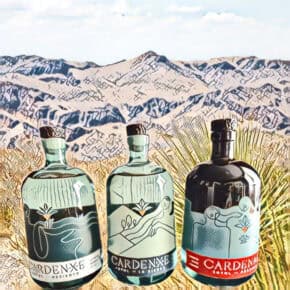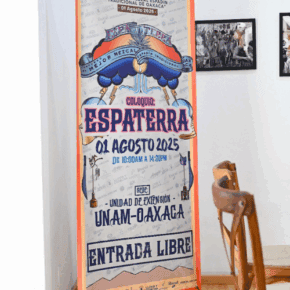Earlier this year we asked mezcal wrangler extraordinaire Erick Rodriguez, aka Erick Almamezcalera, what he thought about the current state of the mezcal world. We’re publishing his comment along with a follow up lower down in this post in anticipation of his West Coast swing which starts tonight in LA and runs into next week. He will be leading tastings of Vino de Mezcal, the super rare (indeed they may already be sold out) line of mezcals from a variety of locations across Mexico imported by the Fundación Agaves Silvestres.
We can’t stress how rare this line of mezcals is and how they communicate just an iota of the world of mezcal out there. It’s a fantastic way to expose yourself. And, yes, the price does reflect the work involved because the distillation runs are very limited. Should you need any conscience cleansers the project was created both to bring you these limited delights and to funnel revenue into a truly worthy project of planting wild agaves outside of the town of Oaxaca in San Dionisio Ocotepec.
The translation comes to us courtesy of Gabriel Baum of ModernLanguages.com.
—
Per Erick Rodgriguez here’s what’s up with the world of maguey:
The point of view of many people who only know that mezcal comes from one or two states, or alternatively who only know what is happening in this current “boom”. .. If we don’t do something there will be a lack of maguey-mezcal in a not too distant future.
As was foreseen two years ago, the “looting” of maguey raised a level of disquiet among people who may or may not have known that this supposed “looting” (there is really no such thing) had already been going on since the 70’s. There are people, the same as those who exist in all types of Mexican businesses, who pay the mezcal producers for their maguey or for their mezcal at a higher price. This happens and will go on happening because there is no price that is worthy of their mezcal. There were tequilas that were made in Oaxaca from the 70’s onwards, that were marketed this way, here and abroad; for example Tequila Porfidio. From that point onwards there were irregularities, there were no rules or regulations for mezcal let alone anyone who would stand in the way of this development. Because, remember, traditional mezcal was only drunk and marketed within the communities in which it was grown, and elsewhere it was only known as a nasty drink of bad quality, or a poor person’s drink. So the village chiefs bought it or bartered it for their daily needs.
Thanks to the media coverage and to the interest of a few people or brands, it was marketed and distributed in this new “boom.” Some do it openly, others are masked and, as a result, there are a whole lot of people and personalities behind each marketer of mezcal. Nowadays “everyone knows about mezcal” and wants to have a brand, some because of the cachet, some because of fashion.
People! There are a lot of types of maguey in other states, it’s just that Oaxaca has the greatest number of types and varieties in the world. But another problem that we have is that we are using the wild maguey as a draw. People know that maguey is scarce and they want to stockpile all that is left on the mountains and in the valleys before someone else buys it and it acquires more prestige as a mezcal. Many people want to have something that maybe in the not-too-distant future might be a piece of history as in “once there was a maguey called Cuarentero and this Master Mezcalista only has one maguey of this variety left”
There are internal regulations or rules that are followed by each marketer or that say “This maguey is an ‘x’ and we are replanting 2000 new plants so drink it with pleasure because mezcal of this variety will always exist – Are there really such rules? Or are we really saying “Drink this because it is like the last panda bear on the planet and this is your only chance”.
Regulatory centers? People, we know this was badly done right from the beginning in 1994; it’s a matter of wiping them out and starting afresh. It’s a matter, for example, of taking actions with one’s own producers, otherwise it’ll be the same as what happens in every “boom”.
Well, maybe if each time is different, the difference is that the biodiversity of the maguey plants is being lost and won’t be with us for the next “boom” which will take place again in 15 to 25 years. And we don’t know if we’ll know what to do. Significant interests exist behind the scenes and they will continue to be driven by the industry. Taking action with your producers would be a good start. Make them part of the decision-making process and make them feel supported by paying them better so that they don’t have to sell off or squander their maguey.
The latter is what is happening in Durango, lately more than 5 tons of juice are leaving WEEKLY, and the owner was very clear with me: “I would like to have cash jingling in my pocket. If I turn it into mezcal it’s not so good for me and if I sell it as juice they pay me better and I don’t have to wait for them to come or to distribute it. If I store it it’s not good for me either because I haven’t got money for promotions, bottles, labels, transport etc. These days they pay me better for the juice and that’s what we need, money coming in so that we can go on sowing maguey.”
So, what will you do Mezcalista friend? Would you take some real actions? Help spread the category/concept of mezcal or just advertise brand names and drinking places? Where to start? Who’s responsible for all this? Many people who have been organized since the 90s produce almost 4 million magueys a year to cover their demand. Does this tell you something?
Whenever you’d like to discuss and have work groups on the subject… It would be a great pleasure for me to be invited and to take part. If you have any questions or doubts we can discuss them. Personally. I am at your disposal. Erick Almamezcalera.
—
We chatted really quickly with Erick earlier this week in advance of his tasting tour of the West Coast:
What I’m bringing this time to the USA is the voice and responsibility of master mezcaleros, we want people to be able to identify different types of mezcal and the methods of production that are being used, the types of maguey and where agave distillations are produced in Mexico. We will show that there are three types of mezcal, namely industrialized, artisanal and traditional. We will get to know what is “Mezcal Wine.” (Vino de Mezcal) What to look for? What is there behind each one of the distillations, creating traditional micro-harvests each one of which has the fully named varietals. Our mezcals are a traditional Mexican drink extracted from wild agave and made by master mezcaleros with ancestral knowledge, respecting traditional manufacturing processes and, as a result, offering us soul enriching experiences and unforgettable states of consciousness.
With the responsible consumption of our mezcal you help to keep this thousand year tradition alive, you support the sustainability of more producing communities, you strengthen fair trade and you help avoid the inclusion of industrial structures in the production of this drink.
—












Leave a Comment